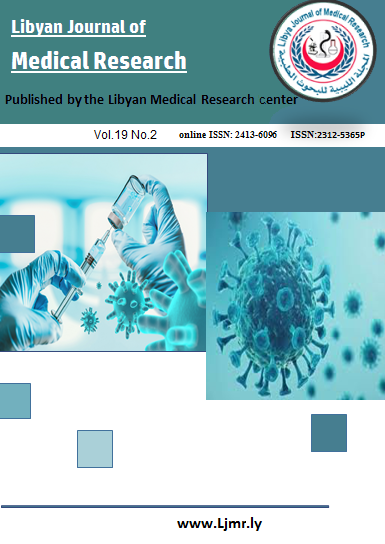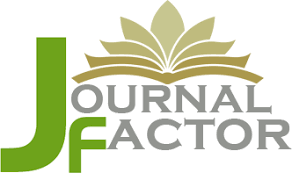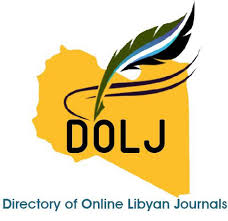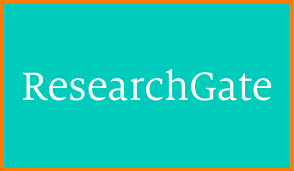Assessment of Nurses' Knowledge and Practices in Diabetic Foot Ulcer Care at Al-Zawia Medical Center – Libya.
DOI:
https://doi.org/10.54361/LJMR.19.2.37Keywords:
Diabetic Foot Ulcer, Nurses' Knowledge, Zawia, LibyaAbstract
Background: Diabetic foot ulcers are one of the most common diabetic complications found today. These ulcers can often lead to infection, gangrene, limb amputation, and even death. Objectives: The aim of this study was to assess the level of nurses' knowledge and practices concerning the care of diabetic foot ulcer patients. Material and Methodology: This was a hospital-based design study among one hundred (100) consented working nurses at Al-Zawia Medical Center, Western Libya, both gender (49 males and 51 females) were recruited during the period from December 2024, to April 2025, demographic data were collected by validated structured questionnaire, and analyzed, frequency and percentage calculated by known medical statistician. Results: The study indicated that half of the nurses were aged between 18 and 28 years, 51% of the participants were female, and most of them had a Nursing Certificate (39%). The study revealed that the participants gained a moderate level of knowledge among the nurses at Al Zawia Medical Center- Libya. However, regarding experiences and training, results were found that (56%) had less than 5 years of experience and (43%) did not receive training in diabetic foot care, highlighting a knowledge gap, particularly in duration and quality of training. Conclusion: The findings of this study revealed that the majority of nurses working in different wards at Al-Zawia Medical Center, with various educational levels, short periods of experience and practice, have a moderate level of knowledge concerning diabetic foot care, and generally, there are specific gaps, particularly in continuous training, knowledge, quality, and adequate period of practice.
Downloads
References
1. Hajwal SK, Elfeshawy R, Ayad ZM. Nurses’ Knowledge toward Nursing Care of Diabetic Foot Ulcers at Diabetic Center in Merjan Medical City, EJHC. 2024 June; 15(2):1048-57.
2. Ramzan U, Sarwar H, Rafique M, Aslam S, Yasmeen F. Assess The Nurses’ Knowledge and Practice Regarding Diabetic Foot Care at Private Hospitals.JHWCR.2025 Jul;3(8):1-7.
3. Hasdi H. Syahrul. S, & Yusuf. S. Nurses’ Knowledge about Diabetes Foot Ulcer Prevention and Treatment: An Integrative Review . ICON Journal. 2022 Aug; 7(1): 25-35. https://doi.org/10.20956/icon.v7i1.20769
4. Sadiqullah, SH, Jabeen R. Nurses’ knowledge, attitudes and practices regarding diabetic foot ulcers. Biol Clin Sci Res J. 2024 Dec; (1): 1394-98. https://doi.org/10.54112/bcsrj.v2024i1.1394
5. Arruda LSNS, Fernandes CRS, Freitas RWJF, Machado ALG, Lima LHO, Silva ARV. Nurses' knowledge about Caring for Diabetic Foot. J Nurs UFPE on line. 2019 Nov;13: e242175 DOI: https://doi.org/10.5205/1981-8963.2019.242175.
6. Alkhatieb M, Abdulwassi H, Fallatah A, Alghamdi K, Al-Abbadi W, Altaifi R. Knowledge of Diabetic Foot Among Nurses at a Tertiary Hospital in Saudi Arabia. Med Arch. 2022 Jun;76(3):190 -7.
7. doi: 10.5455/medarh.2022.76.190-197. PMID: 36200121; PMCID: PMC9478813.
8. Kaya Z, Karaca A. Evaluation of Nurses' Knowledge Levels of Diabetic Foot Care Management. Nurs Res Pract. 2018 Jul 2;2018:8549567. doi: 10.1155/2018/8549567. PMID: 30057810; PMCID: PMC6051007.
9. Dung N, Nguyen A, Lam N, Dung P, An N, Huong N. Nurses’ Knowledge of Diabetic Foot Ulcer Management in North Vietnam. Open Nurs J, 2025 May; 19: e18744346394285. http://dx.doi.org/10.2174/0118744346394285250505094845
10. Ahmed FA, Adel M, Zienulabeden A, Mokhtar I. Nurses’ Performance Regarding Peripheral Neuropathy and Diabetic Foot Management. Jhcr.2025 Jan; 2(1): 39-59. https://jhcr.journals.ekb.eg.
11. Oh J. Clinical spectrum and diagnosis of diabetic neuropathies. Korean J Intern Med. 2020 Sep; 35(5):1059-69.Doi: 10.3904/kjim.2020.202. Epub 2020 Aug 28. PMID: 32921007; PMCID: PMC7487299.
12. S. Waheida, M. B. Elshemy, and A. A. Basal. Effect ofeducational program about foot care on nurses’ knowledgepracticeand outcomes for patients with diabetes, JNHS. 2015;4(6): pp. 67–77.
13. K. Bakker, J. Apelqvist, and N. C. Schaper, Practical guidelineson the management and prevention of the diabetic foot Diabetes / MetabolismResearch and Reviews, 2012 vol. 28, supplement pp. 225–31.
14. -Jeffcoate WJ, Vileikyte L, Boyko EJ, Armstrong DG, Boulton AJM. Current Challenges and Opportunities in the Prevention and Management of Diabetic Foot Ulcers. dcJ. 2018 Apr; 41(4):645-52. doi: 10.2337/dc17- 36. PMID: 29559450.
15. Chuang ST, Shu FL, Liao PL, Lin PY, Tsay SF. Knowledge, attitude, perceived barriers of hard-to-healed wound care and the association with confidence: A cross-sectional study among community nurses. JTV. 2023 Aug; 32: 487-92. https://doi.org/10.1016/j.jtv.2023.08.003
16. Mafusi LG, Egenasi CK, Steinberg WJ, Benedict MO, Habib T, Harmse M, Rooyen CV. Knowledge, attitudes and practices on diabetic foot care among nurses in Kimberley, South Africa. Safpj. 2024 June; 66(1), a5935-45. https://doi.org/10.4102/safp.v66i1.5935 .
17. Iraj B, Khorvash F, Ebneshahidi A, Askari G. Prevention of diabetic foot ulcer. Int J Prev Med. 2013 Mar;4(3):373-6. PMID: 23626896; PMCID: PMC3634178.
Downloads
Published
Issue
Section
License
Copyright (c) 2025 Siddig Bushra Mohamed, Salih A. Elmahdi, Abdelmoez Eshrif, Abdelkrem Mohamed Abdalla, Ibrahim H. Mohamed, Ahmed M. Aljnien, Elaf A. Almogwas, Hashem M. Abdelmola, Khalifa A.Almzalet (Author)

This work is licensed under a Creative Commons Attribution-NonCommercial-NoDerivatives 4.0 International License.
Open Access Policy
Libyan journal of medical Research (LJMR).is an open journal, therefore there are no fees required for downloading any publication from the journal website by authors, readers, and institution.
The journal applies the license of CC BY (a Creative Commons Attribution 4.0 International license). This license allows authors to keep ownership f the copyright of their papers. But this license permits any user to download , print out, extract, reuse, archive, and distribute the article, so long as appropriate credit is given to the authors and the source of the work.
The license ensures that the article will be available as widely as possible and that the article can be included in any scientific archive.
Editorial Policy
The publication of an article in a peer reviewed journal is an essential model for Libyan journal of medical Research (LJMR). It is necessary to agree upon standards of expected ethical behavior for all parties involved in the act of publishing: the author, the journal editorial, the peer reviewer and the publisher.
Any manuscript or substantial parts of it, submitted to the journal must not be under consideration by any other journal. In general, the manuscript should not have already been published in any journal or other citable form, although it may have been deposited on a preprint server. Authors are required to ensure that no material submitted as part of a manuscript infringes existing copyrights, or the rights of a third party.
Authorship Policy
The manuscript authorship should be limited to those who have made a significant contribution and intellectual input to the research submitted to the journal, including design, performance, interpretation of the reported study, and writing the manuscript. All those who have made significant contributions should be listed as co-authors.
Others who have participated in certain substantive aspects of the manuscript but without intellectual input should only be recognized in the acknowledgements section of the manuscript. Also, one of the authors should be selected as the corresponding author to communicate with the journal and approve the final version of the manuscript for publication in the LJMR.
Peer-review Policy
- All the manuscripts submitted to LJMR will be subjected to the double-blinded peer-review process;
- The manuscript will be reviewed by two suitable experts in the respective subject area.
- Reports of all the reviewers will be considered while deciding on acceptance/revision or rejection of a manuscript.
- Editor-In-Chief will make the final decision, based on the reviewer’s comments.
- Editor-In-Chief can ask one or more advisory board members for their suggestions upon a manuscript, before making the final decision.
- Associate editor and review editors provide administrative support to maintain the integrity of the peer-review process.
- In case, authors challenge the editor’s negative decision with suitable arguments, the manuscript can be sent to one more reviewer and the final decision will be made based upon his recommendations.














